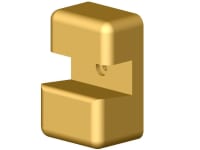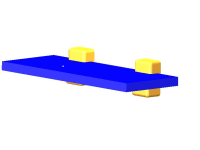This design offers a better method for the placement of a shelf. Many past and current methods place the shelf on a bracket where the shelf is either permanently secured or requires timely labor to remove it from the wall. Once the bracket is mounted to the wall, this design allows very easy installation and removal of any shelf, as a result with the removal, permitting easy access for wall cleaning or painting or quickly freeing more usable floor area, or in the designer’s case quick access to power cords behind their electronic equipment.
This bracket, Illustration 1, can be manufactured for architectural or commercial/industrial usage. It can be created to accept many types of shelving materials in a variety of thicknesses. The bracket’s design shape could be lengthened horizontally to accommodate an increase need in the shelf’s potential loading.
Architecturally, in a simple two brackets and shelf arrangement, Illustration 2, the footprint of two brackets is minimal. This allows the shelf, and the items being displayed, to appear prominent against the wall surface. If the bracket is lengthened horizontally, the overall impact still allows few observed parts thus more visibility of the shelf and its displayed items.
From a commercial/industrial standpoint, the bracket will allow quick expansion of a storage area for placement of items. As the items leave, the shelf is quickly removed and the area returns to its previous situation.
There is a market for these brackets. Architects, builders and homeowners would desire their simplicity and appearance. The prototypes were made from Mahogany and the shelf from clear White Pine. Their assembled appearance is quite visually striking against the wall where they are mounted. From a commercial/industrial aspect, this bracket allows an organization to quickly expand their storage capabilities. Many organizations use just-in-time or lean production systems. This bracket with a shelf would be ideal for storing ‘widgets’ before they are moved to production. When all are in production, the shelf is removed and the floor space is, again, returned to its original state. Small to medium organizations would definitely have a need as their storage space tends to be minimal.
The unique detail of the bracket, Illustration 3, is the interior profile. The shelf is slide into the slot on a slight downward angle. Upon reaching the rear, lower the shelf to its final perpendicular wall position. The shelf pivots on two surfaces. This pivot permits the shelf to rest properly should the shelf be slightly over or under in its thickness.
The bracket can be manufactured by casting, extrusion, or machine centers. Brackets of wood, aluminum and plastic are possible. The material would be dictated by the shelf’s usage and potential loading. Finally, the cost will be competitive to most current shelving systems. The simplicity of the bracket replaces permanent vertical wall strips and their shelf supports, ‘L’ brackets and most standing shelves. The manufacturing methods mentioned lend themselves to economically produced parts.
Like this entry?
-
About the Entrant
- Name:Orville Fleming
- Type of entry:individual
- Software used for this entry:Solid Works
- Patent status:pending








